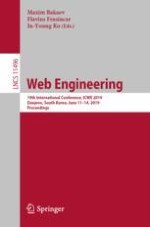This book constitutes the refereed proceedings of the 19th International Conference on Web Engineering, ICWE 2019, held in Daejeon, South Korea, in June 2019.
The 26 full research papers and 9 short papers presented were carefully reviewed and selected from 106 submissions. Additionally, two demonstrations, four posters, and four contributions to the PhD symposium as well as five tutorials are included in this volume. The papers cover research areas such as Web mining and knowledge extraction, Web big data and Web data analytics, social Web applications and crowdsourcing, Web user interfaces, Web security and privacy, Web programming, Web services and computing, Semantic Web and linked open data applications, and Web application modeling and engineering.
